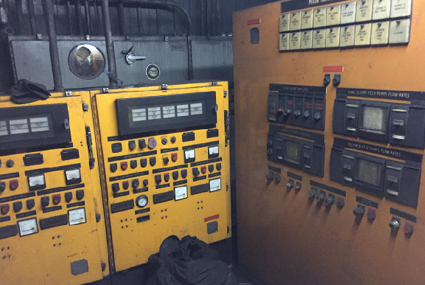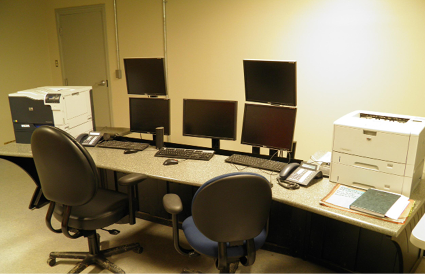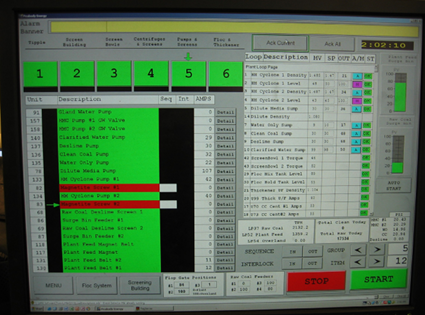Many of the changes in today’s prep control room have been more gradual, such as efficiency improvements on the processing side of a plant. Conversely, control systems technology has been quickly changing and continues to evolve rapidly. While many facilities have come into the 21st century from that perspective, others either have not made any of these crucial upgrades at all or are still making changes with each budget year as part of a phased approach. Tomorrow’s trends in control systems technology for today’s control room is very reflective of the overall technical evolution — and revolution — that has taken over the world, both inside and outside of the industry. The control room no longer has to be in the control room.
A popular control board model from the 1970s and 1980s.
Coal Age recently spoke with Harry Evans, general manager of electrical services for DRA Taggart, who noted the changes plants should be making if such upgrades have not been made, as well as some trends for the future.
For example, a search through the company’s history will unearth countless prep complexes seeking the latest in closed-circuit television for that respective time period. With the emergence of the Digital Age, the wall filled with clunky tube-type television sets were replaced with flat panel screens powered with digital modes and Power over Ethernet capabilities. “It has changed the way CCTV is installed and operated,” Evans said. “Advanced camera functions and digital alarming and recording has given operators and managers a new tool.”
Taking these changes a step further, operators began asking for — and suppliers responded by designing — technology with the ability to literally take the control room out of the control room. The individual that was once tethered in many ways to the room to keep peak uptime, make adjustments to the plant’s levels and ensure key movements were being made, no longer needs to be within those walls to oversee these tasks.

Control systems technology in mining have quickly evolved over the last several decades.
This has become increasingly important with changes in the industry that have left companies doing more with less, including asking a smaller crew of plant workers to manage functions that a group double its size did just a few years ago. With remote monitoring now fairly commonplace, according to Evans, control systems designers are offering some kind of web access capability within its software. If there is an internet connection, there is a way to see, adjust and troubleshoot.
When troubleshooting uncovers a bigger issue, remote technology obviously has another important advantage: the ability for the system’s maker to assist with diagnosis, programming and maintenance. Gone are the days of plants needing to keep on-site technical staff or waiting days for technical assistance, losing money every minute and potentially bottlenecking the mine that feeds it, compounding that financial loss.
“Today’s plant electrician needs to be part IT guy, part programmer, and that is why remote access is critical when technical issues arise. We try to encourage new clients to include remote access to their control software,” Evans said. “Again, internet access is the key.”
That idea of “total access anywhere” has really been a motivating factor for suppliers, including DRA Taggart, moving forward, and many of the trends the company is seeing as the industry powers on. Technology stops for nothing — not even changes in the market — and prep plants remain committed to staying running in the safest and most productive ways possible and protecting every element of the facility’s everyday operation. Both existing and potential customers are still looking at upgrades, planning budgets and ordering those things that will keep them running at peak levels — and that push, at least on the control systems end of things, is largely being led by remote capabilities.
“Two recent operations, a plant in Indiana and a loading facility in Texas, have benefited from remote access,” Evans said of two of its projects where this element was crucial. “We set up the capability and then arrange a retainer agreement for callouts and revisions. Technicians have 24/7 capability for trouble calls [to] avoid delays related to travel to remote sites. It has been very successful; it saves the client valuable production time.”
“We try to promote this capability as a hedge against lost production time. We have, on occasion, gone back to past projects to market the capability with limited success. In some cases, especially utility customers, there seems to be a concern for security of the system in regard to malicious access, but we know of no issues.”
He reported that DRA Taggart control supplier partner Rockwell (Allen-Bradley) has seen a significant increase in need for comprehensive programmable control and software products like its ControLogix PLC. In fact, it’s been what he called a “mainstay system” in the company’s travels to some plants that are still migrating from older systems that the original equipment manufacturer (OEM) no longer supports.
“We have experience with both Eaton and AB that have ‘smart’ motor control centers that interface directly with the operator’s HMI and allow supervision, control and troubleshooting of the MCC from the operator’s HMI,” Evans said. “These features are also available in web-based applications that add another level of remote troubleshooting and maintenance capability.”
DRA Taggart has also received plenty of feedback from facilities on distributed control systems; it again teams with Rockwell in these cases with solutions like PlantPAx, which offers plant-wide control and optimization with open, secure, information-enabled networking while remaining scalable to fit both small and larger plants.
There have, of course, been challenges; hesitations due to cost, older workers being uncomfortable with new “bells and whistles,” and an overall resistance to change for fear of efficiency loss or downtime potential have all come up over time as DRA Taggart has moved from plant to plant to bring this technology forward. Proper training and a complete understanding of the functionality that is coming into the control room — especially those things that will make jobs easier, like the peace of mind that comes with remote access — has been able to offset some of those obstacles, but some still remain.

The modern, streamlined control station can permit monitoring elsewhere in the plant or even from off-site.
“We like to promote the new technology, but there is limited call for advanced systems; one additional reason is standardization. [One] client has an existing system and wants to standardize to maximize on spare parts and personnel familiarity. This is not only for expansion of existing plants, but for new facilities, especially where you have corporate management over multiple sites,” he said.
One upcoming trend, the Internet of Things (IoT), hasn’t quite taken the coal community by storm, at least not yet. IoT-connected enterprises such as embedded intelligence and smart instrumentation that stems from combining information technology and operational technology functions.

A typical plant process screen that can be viewed on a PC or connected tablet.
“The Connected Enterprise helps operations managers profitably manage and improve manufacturing and industrial processes,” Evans said. “In our discussions with Jim Burton at State Electric, the advanced software packages from Rockwell help to reduce network complexities and exposure to information security risks [and] shares productivity-improving information to workers across the organization in a context that is meaningful for each role.” The ability to be more competitive by being able to make better real-time decisions, such as data analytics, remote monitoring and mobility — has changed perspectives in other areas of mining.
Across coal as a whole, current areas of focus for plants making changes seem to be improving fine coal recovery and dewatering. While there are several new plants in the planning and design stages, their construction is unlikely at least in the short-term, so DRA Taggart’s own focus has been on upgrade projects.
There’s no question, though, where coal is headed, Evans said. The coal preparation plant has unquestionably changed for the better; a dark, dusty, and noisy environment with a pile of push-buttons and lights one would have found at yesterday’s control room is now anything but this antiquated vision.
“It is powerful and portable, networked and wireless, with internet access, accessible anywhere in the world,” Evans said. “Advanced data acquisition, networking, storage and reporting for today’s sophisticated plant manager are within…reach. It is perfectly aligned with our present computer-savvy generation and flexible enough to meet the demands of the future.”




